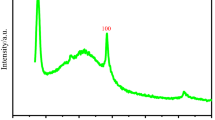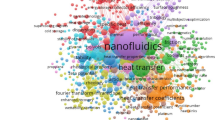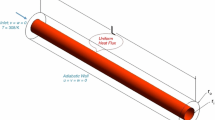Abstract
In this research, the effect of using GO/ water nanofluid as a coolant fluid in an isothermal heat transfer system was studied. At first, to evaluate the atomic bond, chemical, and surface structure of the nanoparticles, XRD-FTIR and FESEM tests were used. Two-step method was used to prepared nanofluid then DLS test was utilized to examine the stability of the nanofluid. Thermal conductivity and the dynamic viscosity were measured experimentally from 25 to 75 ℃ and volume fractions of 0–0.15%. The maximum improvement in thermal conductivity is 11.2% at 0.15% and 75 ℃. Also The dynamic viscosity increased. The validity and uncertainty of the test results were examined. The heat transfer and turbulent flow of the nanofluid under a constant temperature boundary condition were investigated between 6000 and 18,700 Reynolds numbers. Various parameters such as the pressure drop, friction factor, convection heat transfer coefficient, and Nusselt number of the turbulent flow were evaluated. According to the results, the greatest increase in the convection heat transfer coefficient of the nanofluid was 34.7% compared to that of the base fluid. Also, the greatest enhancement in the friction factor was 9.64%. It can be stated that the improvement of the convection heat transfer coefficient dominantly affects the pressure drop so this nanofluid can be used as a coolant fluid in industrial systems.














Similar content being viewed by others
References
Jafaryar M, Sheikholeslami M, Li Z. CuO-water nanofluid flow and heat transfer in a heat exchanger tube with twisted tape turbulator. Powder Technol. 2018;336:131–43.
Akyürek EF, Geliş K, Şahin B, Manay E. Experimental analysis for heat transfer of nanofluid with wire coil turbulators in a concentric tube heat exchanger. Results Phys. 2018;9:376–89.
Liu S, Sakr M. A comprehensive review on passive heat transfer enhancements in pipe exchangers. Renew Sustain Energy Rev. 2013;19:64–81.
Dogan M, İgci AA. An experimental comparison of delta winglet and novel type vortex generators for heat transfer enhancement in a rectangular channel and flow visualization with stereoscopic PIV. Int J Heat Mass Transf. 2021;164:120592.
Zhu C-Y, Guo Y, Yang H-Q, Ding B, Duan X-Y. Investigation of the flow and heat transfer characteristics of helium gas in printed circuit heat exchangers with asymmetrical airfoil fins. Appl Therm Eng. 2021;186:116478.
Mousa MH, Miljkovic N, Nawaz K. Review of heat transfer enhancement techniques for single phase flows. Renew Sustain Energy Rev. 2021;137:110566.
Ranjbarzadeh R, Meghdadi Isfahani AH, Hojaji M. Experimental investigation of heat transfer and friction coefficient of the water/graphene oxide nanofluid in a pipe containing twisted tape inserts under air cross-flow. Exp Heat Transf. 2018;31:373–90.
Mozaffari M, Karimipour A, D’Orazio A. Increase lattice Boltzmann method ability to simulate slip flow regimes with dispersed CNTs nanoadditives inside. J Therm Anal Calorim. 2019;137:229–43.
Khan IA. Experimental validation of enhancement in thermal conductivity of titania/water nanofluid by the addition of silver nanoparticles. Int Commun Heat Mass Transf. 2021;120:104910.
Choi SU, Eastman JA. Eastman, Enhancing thermal conductivity of fluids with nanoparticles, in, Argonne National Lab., IL (United States); 1995
Pandey RP, Shukla G, Manohar M, Shahi VK. Graphene oxide based nanohybrid proton exchange membranes for fuel cell applications: an overview. Adv Coll Interface Sci. 2017;240:15–30.
Dikin DA, Stankovich S, Zimney EJ, Piner RD, Dommett GH, Evmenenko G, Nguyen ST, Ruoff RS. Preparation and characterization of graphene oxide paper. Nature. 2007;448:457–60.
Bashirnezhad K, Ghavami M, Alrashed AA. Experimental investigations of nanofluids convective heat transfer in different flow regimes: A review. J Mol Liq. 2017;244:309–21.
Qi C, Luo T, Liu M, Fan F, Yan Y. Experimental study on the flow and heat transfer characteristics of nanofluids in double-tube heat exchangers based on thermal efficiency assessment. Energy Conversi Manag. 2019;197:111877.
Sadeghinezhad E, Mehrali M, Rosen MA, Akhiani AR, Latibari ST, Mehrali M, Metselaar HSC. Experimental investigation of the effect of graphene nanofluids on heat pipe thermal performance. Appl Therm Eng. 2016;100:775–87.
Ranjbarzadeh R, Karimipour A, Afrand M, Isfahani AHM, Shirneshan A. Empirical analysis of heat transfer and friction factor of water/graphene oxide nanofluid flow in turbulent regime through an isothermal pipe. Appl Therm Eng. 2017;126:538–47.
Prasad PD, Gupta A. Experimental investigation on enhancement of heat transfer using Al2O3/water nanofluid in a u-tube with twisted tape inserts. Int Commun Heat Mass Transf. 2016;75:154–61.
Yarmand H, Gharehkhani S, Shirazi SFS, Amiri A, Alehashem MS, Dahari M, Kazi S. Experimental investigation of thermo-physical properties, convective heat transfer and pressure drop of functionalized graphene nanoplatelets aqueous nanofluid in a square heated pipe. Energy Convers Manage. 2016;114:38–49.
Devireddy S, Mekala CSR, Veeredhi VR. Improving the cooling performance of automobile radiator with ethylene glycol water based TiO2 nanofluids. Int Commun Heat Mass Transfer. 2016;78:121–6.
Kumar V, Tiwari AK, Ghosh SK. Characterization and performance of nanofluids in plate heat exchanger. Mater Today: Proc. 2017;4:4070–8.
Sarafraz M, Nikkhah V, Nakhjavani M, Arya A. Thermal performance of a heat sink microchannel working with biologically produced silver-water nanofluid: experimental assessment. Exp Thermal Fluid Sci. 2018;91:509–19.
Kumar NR, Bhramara P, Addis BM, Sundar LS, Singh MK, Sousa AC. Heat transfer, friction factor and effectiveness analysis of Fe3O4/water nanofluid flow in a double pipe heat exchanger with return bend. Int Commun Heat Mass Transfer. 2017;81:155–63.
Bergman TL, Incropera FP, DeWitt DP, Lavine AS. Fundamentals of heat and mass transfer. United States: John Wiley & Sons; 2011.
Pak BC, Cho YI. Hydrodynamic and heat transfer study of dispersed fluids with submicron metallic oxide particles. Exp Heat Transf Int J. 1998;11:151–70.
Bergman TL, Incropera FP, Lavine AS, Dewitt DP. Introduction to heat transfer. United States: John Wiley & Sons; 2011.
Moffat RJ. Describing the uncertainties in experimental results. Exp Thermal Fluid Sci. 1988;1:3–17.
Winterton RH. Where did the Dittus and Boelter equation come from? Int J Heat Mass Transf. 1998;41:809–10.
Aboutalebi SH, Gudarzi MM, Zheng QB, Kim JK. Spontaneous formation of liquid crystals in ultralarge graphene oxide dispersions. Adv Func Mater. 2011;21:2978–88.
Javidparvar AA, Naderi R, Ramezanzadeh B, Bahlakeh G. Graphene oxide as a pH-sensitive carrier for targeted delivery of eco-friendly corrosion inhibitors in chloride solution: experimental and theroretical investigations. J Ind Eng Chem. 2019;72:196–213.
Zhu Y, Murali S, Cai W, Li X, Suk JW, Potts JR, Ruoff RS. Graphene and graphene oxide: synthesis, properties, and applications. Adv Mater. 2010;22:3906–24.
El Ghandoor H, Zidan H, Khalil MM, Ismail M. Synthesis and some physical properties of magnetite (Fe3O4) nanoparticles. Int J Electrochem Sci. 2012;7:5734–45.
Ranjbarzadeh R, Akhgar A, Musivand S, Afrand M. Effects of graphene oxide-silicon oxide hybrid nanomaterials on rheological behavior of water at various time durations and temperatures: synthesis, preparation and stability. Powder Technol. 2018;335:375–87.
Ranjbarzadeh R, Isfahani AM, Afrand M, Karimipour A, Hojaji M. An experimental study on heat transfer and pressure drop of water/graphene oxide nanofluid in a copper tube under air cross-flow: applicable as a heat exchanger. Appl Therm Eng. 2017;125:69–79.
Newton RG Scattering theory of waves and particles. Springer Science & Business Media. 2013
Xuan Y, Li Q. Heat transfer enhancement of nanofluids. Int J Heat Fluid Flow. 2000;21:58–64.
Ahmadi MH, Mohseni-Gharyehsafa B, Ghazvini M, Goodarzi M, Jilte RD, Kumar R. Comparing various machine learning approaches in modeling the dynamic viscosity of CuO/water nanofluid. J Therm Anal Calorim. 2020;139(4):2585–99.
Bahiraei M, Jamshidmofid M, Goodarzi M. Efficacy of a hybrid nanofluid in a new microchannel heat sink equipped with both secondary channels and ribs. J Mol Liq. 2019;273:88–98.
Bahmani MH, Sheikhzadeh G, Zarringhalam M, Akbari OA, Alrashed AA, Shabani GAS, Goodarzi M. Investigation of turbulent heat transfer and nanofluid flow in a double pipe heat exchanger. Adv Powder Technol. 2018;29(2):273–82.
Giwa SO, Sharifpur M, Goodarzi M, Alsulami H, Meyer JP. Influence of base fluid, temperature, and concentration on the thermophysical properties of hybrid nanofluids of alumina–ferrofluid: experimental data, modeling through enhanced ANN, ANFIS, and curve fitting. J Therm Anal Calorim. 2021;143(6):4149–67.
Bagherzadeh SA, Jalali E, Sarafraz MM, Akbari OA, Karimipour A, Goodarzi M, Bach QV. Effects of magnetic field on micro cross jet injection of dispersed nanoparticles in a microchannel. Int J Numer Methods Heat Fluid Flow. 2019
Bagherzadeh SA, D’Orazio A, Karimipour A, Goodarzi M, Bach QV. A novel sensitivity analysis model of EANN for F-MWCNTs–Fe3O4/EG nanofluid thermal conductivity: outputs predicted analytically instead of numerically to more accuracy and less costs. Phys A. 2019;521:406–15.
Sarafraz MM, Tian Z, Tlili I, Kazi S, Goodarzi M. Thermal evaluation of a heat pipe working with n-pentane-acetone and n-pentane-methanol binary mixtures. J Therm Anal Calorim. 2020;139(4):2435–45.
Khosravi R, Rabiei S, Khaki M, Safaei MR, Goodarzi M. Entropy generation of graphene–platinum hybrid nanofluid flow through a wavy cylindrical microchannel solar receiver by using neural networks. J Therm Anal Calorim. 2021;1–19.
Abuldrazzaq T, Togun H, Alsulami H, Goodarzi M, Safaei MR. Heat transfer improvement in a double backward-facing expanding channel using different working fluids. Symmetry. 2020;12(7):1088.
Peng Y, Parsian A, Khodadadi H, Akbari M, Ghani K, Goodarzi M, Bach QV. Develop optimal network topology of artificial neural network (AONN) to predict the hybrid nanofluids thermal conductivity according to the empirical data of Al2O3–Cu nanoparticles dispersed in ethylene glycol. Phys A: Stat Mech Appl. 2020;549:124015.
Ahmadi AA, Arabbeiki M, Ali HM, Goodarzi M, Safaei MR. Configuration and optimization of a minichannel using water–alumina nanofluid by non-dominated sorting genetic algorithm and response surface method. Nanomaterials. 2020;10(5):901.
Dadsetani R, Sheikhzadeh GA, Safaei MR, Leon AS, Goodarzi M. Cooling enhancement and stress reduction optimization of disk-shaped electronic components using nanofluids. Symmetry. 2020;12(6):931.
Abdulrazzaq T, Togun H, Goodarzi M, Kazi SN, Ariffin MKA, Adam NM, Hooman K. Turbulent heat transfer and nanofluid flow in an annular cylinder with sudden reduction. J Therm Anal Calorim. 2020;141(1):373–85.
Akkoli KM, Banapurmath NR, Shivashimpi MM, Soudagar MEM, Badruddin IA, Alazwari MA, Yaliwal VS, Mujtaba MA, Akram N, Goodarzi M, Safaei MR. Effect of injection parameters and producer gas derived from redgram stalk on the performance and emission characteristics of a diesel engine. Alex Eng J. 2021;60(3):3133–42.
Safaei MR, Tlili I, Gholamalizadeh E, Abbas T, Alkanhal TA, Goodarzi M, Dahari M. Thermal analysis of a binary base fluid in pool boiling system of glycol–water alumina nano-suspension. J Therm Anal Calorim. 2021;143(3):2453–62.
Nguyen Q, Beni MH, Parsian A, Malekahmadi O, Karimipour A. Discrete ordinates thermal radiation with mixed convection to involve nanoparticles absorption, scattering and dispersion along radiation beams through the nanofluid. J Therm Anal Calorim. 2021;143(3):2801–24.
Zheng Y, Zhang X, Nouri M, Amini A, Karimipour A, Hekmatifar M, Sabetvand R, Ngooyen Q, Karimipour A. Atomic rheology analysis of the external magnetic field effects on nanofluid in non-ideal microchannel via molecular dynamic method. J Therm Anal Calorim. 2021;143(2):1655–63.
Yan SR, Kalbasi R, Parvin A, Tian XX, Karimipour A. Comparison of Nusselt number and stream function in tall and narrow enclosures in the mixed convection of hybrid nanofluid. J Therm Anal Calorim. 2021;143:1599–609.
Niknejadi M, Afrand M, Karimipour A, Shahsavar A, Isfahani AHM. Experimental investigation of the hydrothermal aspects of water–Fe 3 O 4 nanofluid inside a twisted tube. J Therm Anal Calorim. 2020;143(1):801–10.
Liu X, Toghraie D, Hekmatifar M, Akbari OA, Karimipour A, Afrand M. Numerical investigation of nanofluid laminar forced convection heat transfer between two horizontal concentric cylinders in the presence of porous medium. J Therm Anal Calorim. 2020;141(5):2095–108.
Zheng Y, Yaghoubi S, Dezfulizadeh A, Aghakhani S, Karimipour A, Tlili I. Free convection/radiation and entropy generation analyses for nanofluid of inclined square enclosure with uniform magnetic field. J Therm Anal Calorim. 2020;141(1):635–48.
Yan SR, Kalbasi R, Nguyen Q, Karimipour A. Rheological behavior of hybrid MWCNTs-TiO2/EG nanofluid: a comprehensive modeling and experimental study. J Mol Liq. 2020;308:113058.
Tian XX, Kalbasi R, Qi C, Karimipour A, Huang HL. Efficacy of hybrid nano-powder presence on the thermal conductivity of the engine oil: an experimental study. Powder Technol. 2020;369:261–9.
Salimpour MR, Darvanjooghi MHK, Abdollahi A, Karimipour A, Goodarzi M. Providing a model for Csf according to pool boiling convection heat transfer of water/ferrous oxide nanofluid using sensitivity analysis. Int J Numer Method Heat Fluid Flow. 2019;30(6):2867–81.
Tian Z, Bagherzadeh SA, Ghani K, Karimipour A, Abdollahi A, Bahrami M, Safaei MR. Nonlinear function estimation fuzzy system (NFEFS) as a novel statistical approach to estimate nanofluids’ thermal conductivity according to empirical data. Int J Numer Method Heat Fluid Flow. 2019;30(6):3267–81.
Yan SR, Shirani N, Zarringhalam M, Toghraie D, Nguyen Q, Karimipour A. Prediction of boiling flow characteristics in rough and smooth microchannels using molecular dynamics simulation: Investigation the effects of boundary wall temperatures. J Mol Liq. 2020;306:112937.
Ma J, Shahsavar A, Al-Rashed AA, Karimipour A, Yarmand H, Rostami S. Viscosity, cloud point, freezing point and flash point of zinc oxide/SAE50 nanolubricant. J Mol Liq. 2020;298:112045.
Abu-Hamdeh NH, Alsulami RA, Alimoradi A, Karimipour A. Fluid flow and heat transfer of the two-phase solid/liquid mixture at the equilibration phase structure via MD method: Atomic value effects in a case study of energy consumption and absorbed energy. J Mol Liq. 2021;337:116384.
Alazwari MA, Abu-Hamdeh NH, Nusier OK, Karimipour A. Vacancy defect influence on nanofluid flow and absorbed thermal energy in a nanochannel affected by universal force field via composed approach of embedded atom model/molecular dynamics method. J Mol Liq. 2021;333:115927.
Bantan RA, Abu-Hamdeh NH, Nusier OK, Karimipour A. The molecular dynamics study of aluminum nanoparticles effect on the atomic behavior of argon atoms inside zigzag nanochannel. J Mol Liq. 2021;331:115714.
Author information
Authors and Affiliations
Contributions
Ramin Ranjbarzadeh: Funding acquisition; Project administration; Writing—review & editing, Alireza Akhgar: Formal analysis; Writing—review & editing; Supervision; Methodology, Roozbeh Taherialekouhi: Conceptualization; Writing—original draft, Annunziata D’Orazio: Methodology; Writing—original draft; Validation, S. Mohammad Sajadi: Resources; Writing—original draft, Ferial Ghaemi: Writing—original draft; Validation; Conceptualization, Dumitru Baleanu: Resources; Writing—original draft; Data curation; Supervision.
Corresponding author
Additional information
Publisher's Note
Springer Nature remains neutral with regard to jurisdictional claims in published maps and institutional affiliations.
Rights and permissions
About this article
Cite this article
Ranjbarzadeh, R., Akhgar, A., Taherialekouhi, R. et al. Improve the heat exchanger efficiency via examine the Graphene Oxide nanoparticles: a comprehensive study of the preparation and stability, predict the thermal conductivity and rheological properties, convection heat transfer and pressure drop. J Therm Anal Calorim 147, 7509–7521 (2022). https://doi.org/10.1007/s10973-021-11002-y
Received:
Accepted:
Published:
Issue Date:
DOI: https://doi.org/10.1007/s10973-021-11002-y




